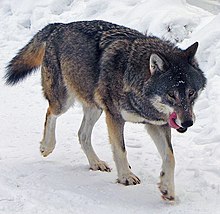Canina (subtribe): Difference between revisions
Content deleted Content added
m →top |
Tedford 2009 comments. |
||
| Line 20: | Line 20: | ||
==Taxonomy== |
==Taxonomy== |
||
{{quote|This subtribe is defined by two synapomorphies: a [[zygoma]] that is strongly arched dorsoventrally, and the usual presence of a second posterior cusp on [[Carnassial|p4]] lying between the first posterior cusp and the [[Cingulum (tooth)|cingulum]].|[[Richard H. Tedford]]<ref name=Tedford2009/>}} |
|||
Members of the subtribe Canina produce [[canid hybrid]]s due to their shared karyotype of 78 chromosomes arranged in 39 pairs.<ref name=wayne1993/> |
|||
The cladogram below is based on the phylogeny of Lindblad-Toh ''et al''. (2005),<ref name=LindbladToh2005/> modified to incorporate recent findings on ''[[Canis]]'' species,<ref name=Koepfli2015/> |
|||
{{Clade |style=font-size:80%; line-height:85% |
{{Clade |style=font-size:80%; line-height:85% |
||
| Line 57: | Line 63: | ||
<ref name=Fischer1817>Fischer de Waldheim, G. 1817. Adversaria zoological. Memoir Societe Naturelle (Moscow) 5:368–428. p372</ref> |
<ref name=Fischer1817>Fischer de Waldheim, G. 1817. Adversaria zoological. Memoir Societe Naturelle (Moscow) 5:368–428. p372</ref> |
||
<ref name=Koepfli2015>{{cite journal |doi=10.1016/j.cub.2015.06.060 |pmid=26234211 |title=Genome-wide evidence reveals that African and Eurasian Golden Jackals are distinct species |journal=Current Biology |volume=25 |issue=16 |pages=2158–2165 |year=2015 |last1=Koepfli |first1=Klaus-Peter |last2=Pollinger |first2=John |last3=Godinho |first3=Raquel |last4=Robinson |first4=Jacqueline |last5=Lea |first5=Amanda |last6=Hendricks |first6=Sarah |last7=Schweizer |first7=Rena M. |last8=Thalmann |first8=Olaf |last9=Silva |first9=Pedro |last10=Fan |first10=Zhenxin |last11=Yurchenko |first11=Andrey A. |last12=Dobrynin |first12=Pavel |last13=Makunin |first13=Alexey |last14=Cahill |first14=James A. |last15=Shapiro |first15=Beth |last16=Álvares |first16=Francisco |last17=Brito |first17=José C. |last18=Geffen |first18=Eli |last19=Leonard |first19=Jennifer A. |last20=Helgen |first20=Kristofer M. |last21=Johnson |first21=Warren E. |last22=o'Brien |first22=Stephen J. |last23=Van Valkenburgh |first23=Blaire |last24=Wayne |first24=Robert K. |display-authors=6|doi-access=free }}</ref>{{rp|page=S1}} |
|||
<ref name=LindbladToh2005>{{cite journal |doi=10.1038/nature04338 |pmid=16341006 |title=Genome sequence, comparative analysis and haplotype structure of the domestic dog |journal=Nature |volume=438 |issue=7069 |pages=803–819 |year=2005 |last1= Lindblad-Toh |first1= Kerstin |last2=Wade |first2= Claire M. |last3=Mikkelsen |first3=Tarjei S. |last4=Karlsson |first4= Elinor K. |last5=Jaffe |first5=David B. |last6=Kamal |first6=Michael |last7=Clamp |first7=Michele |last8=Chang |first8=Jean L. |last9=Kulbokas |first9=Edward J. |last10=Zody |first10=Michael C. |last11=Mauceli |first11=Evan |last12=Xie |first12=Xiaohui |last13=Breen |first13=Matthew |last14=Wayne |first14=Robert K. |last15=Ostrander |first15=Elaine A. |last16=Ponting |first16=Chris P. |last17=Galibert |first17=Francis |last18=Smith |first18= Douglas R. |last19=Dejong |first19=Pieter J. |last20=Kirkness |first20=Ewen |last21=Alvarez |first21=Pablo |last22=Biagi |first22=Tara |last23=Brockmann |first23=William |last24=Butler |first24=Jonathan |last25=Chin |first25=Chee-Wye |last26=Cook |first26=April |last27=Cuff |first27=James |last28=Daly |first28=Mark J. |last29=Decaprio |first29=David |last30=Gnerre |first30= Sante |display-authors=6 |bibcode=2005Natur.438..803L|doi-access=free }}</ref> |
|||
<ref name=Tedford2009>{{cite journal|last1=Tedford|first1=Richard H.|authorlink1=Richard H. Tedford|last2=Wang|first2=Xiaoming|authorlink2=Xiaoming Wang (paleontologist)|last3=Taylor|first3=Beryl E.|year=2009|title=Phylogenetic Systematics of the North American Fossil Caninae (Carnivora: Canidae)|doi=10.1206/574.1|volume=325|journal=[[Bulletin of the American Museum of Natural History]] |pages=1–218|url=http://digitallibrary.amnh.org/bitstream/2246/5999/1/B325.pdf|hdl=2246/5999}}</ref> |
<ref name=Tedford2009>{{cite journal|last1=Tedford|first1=Richard H.|authorlink1=Richard H. Tedford|last2=Wang|first2=Xiaoming|authorlink2=Xiaoming Wang (paleontologist)|last3=Taylor|first3=Beryl E.|year=2009|title=Phylogenetic Systematics of the North American Fossil Caninae (Carnivora: Canidae)|doi=10.1206/574.1|volume=325|journal=[[Bulletin of the American Museum of Natural History]] |pages=1–218|url=http://digitallibrary.amnh.org/bitstream/2246/5999/1/B325.pdf|hdl=2246/5999}}</ref> |
||
Revision as of 09:48, 1 May 2020
| Canina | |
|---|---|

| |
| Wolf | |
| Scientific classification | |
| Domain: | Eukaryota |
| Kingdom: | Animalia |
| Phylum: | Chordata |
| Class: | Mammalia |
| Order: | Carnivora |
| Infraorder: | Cynoidea |
| Family: | Canidae |
| Subfamily: | Caninae |
| Tribe: | Canini Fischer de Waldheim, 1817[1] |
| Genera[2] | |
Canina is a taxonomic rank which represents the wolf-like sub-tribe of the tribe Canini (the true dogs), and is sister to the sub-tribe Cerdocyonina.[2] Its members are colloquially known as wolf-like canids.[3]
Taxonomy
This subtribe is defined by two synapomorphies: a zygoma that is strongly arched dorsoventrally, and the usual presence of a second posterior cusp on p4 lying between the first posterior cusp and the cingulum.
Members of the subtribe Canina produce canid hybrids due to their shared karyotype of 78 chromosomes arranged in 39 pairs.[3]
The cladogram below is based on the phylogeny of Lindblad-Toh et al. (2005),[4] modified to incorporate recent findings on Canis species,[5]
| Canina |
| ||||||
References
- ^ Fischer de Waldheim, G. 1817. Adversaria zoological. Memoir Societe Naturelle (Moscow) 5:368–428. p372
- ^ a b c Tedford, Richard H.; Wang, Xiaoming; Taylor, Beryl E. (2009). "Phylogenetic Systematics of the North American Fossil Caninae (Carnivora: Canidae)" (PDF). Bulletin of the American Museum of Natural History. 325: 1–218. doi:10.1206/574.1. hdl:2246/5999.
- ^ a b Wayne, Robert K. (June 1993). "Molecular evolution of the dog family". Trends in Genetics. 9 (6): 218–224. doi:10.1016/0168-9525(93)90122-x. PMID 8337763.
- ^ Lindblad-Toh, Kerstin; Wade, Claire M.; Mikkelsen, Tarjei S.; Karlsson, Elinor K.; Jaffe, David B.; Kamal, Michael; et al. (2005). "Genome sequence, comparative analysis and haplotype structure of the domestic dog". Nature. 438 (7069): 803–819. Bibcode:2005Natur.438..803L. doi:10.1038/nature04338. PMID 16341006.
- ^ Koepfli, Klaus-Peter; Pollinger, John; Godinho, Raquel; Robinson, Jacqueline; Lea, Amanda; Hendricks, Sarah; et al. (2015). "Genome-wide evidence reveals that African and Eurasian Golden Jackals are distinct species". Current Biology. 25 (16): 2158–2165. doi:10.1016/j.cub.2015.06.060. PMID 26234211.
